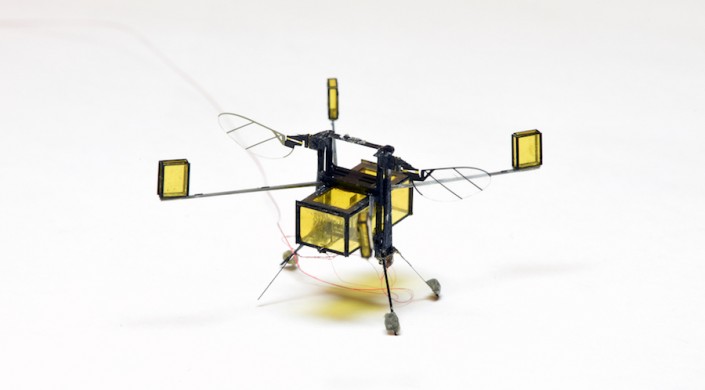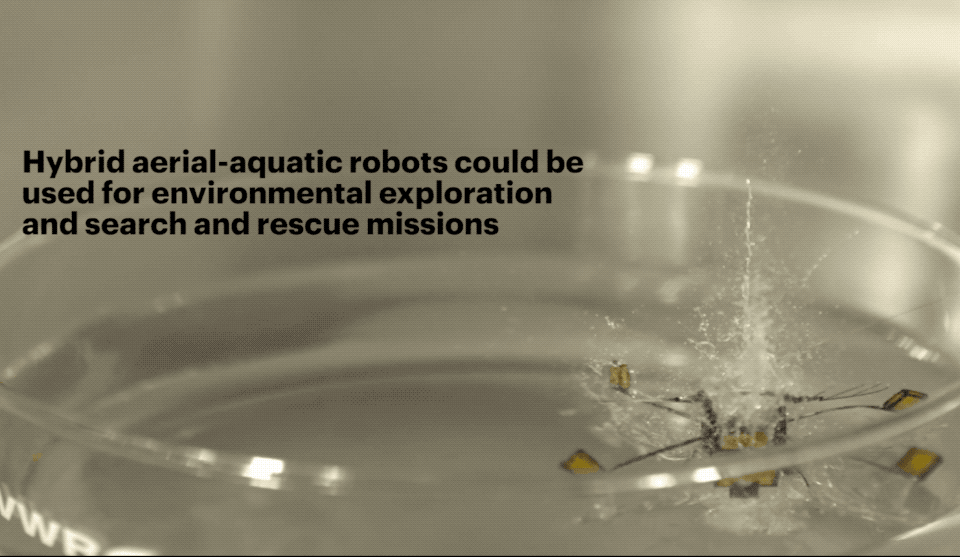Insect-sized robot

Harvard's new RoboBee can fly in and out of water
The team is hoping their work can inspire microrobots that have more capabilities.

Mariella Moon, @mariella_moon
10.26.17 in Robots
Apparently, we haven't seen RoboBee's final form yet. Harvard researchers introduced the robot back in 2013 and developed a version that uses static to stick to walls in 2016.
Now, the scientists have created an upgraded robotic bee that can fly, dive into water and hop right back up into the air.
That's a lot tougher than it sounds, since the tiny machine is only two centimeters tall and is about one-fifteenth the weight of a penny.
For such a small robot, swimming in water is like swimming in molasses and breaking through the water's surface is akin to breaking through a brick wall.
Now, the scientists have created an upgraded robotic bee that can fly, dive into water and hop right back up into the air.
That's a lot tougher than it sounds, since the tiny machine is only two centimeters tall and is about one-fifteenth the weight of a penny.
For such a small robot, swimming in water is like swimming in molasses and breaking through the water's surface is akin to breaking through a brick wall.
To solve the issue, the researchers from Harvard Wyss Institute and
John A. Paulson School of Engineering designed new mechanisms that make
it possible for the RoboBee to transition seamlessly from water to air.
First, they had to figure out the right flapping speeds for its wings in aerial and aquatic environments. By using a combination of theoretical modeling and experimental data, they determined that 220 to 300 hertz is perfect for aerial travel, while 9 to 13 hertz is the perfect speed in the water.
Once that was done, they had to figure out how the machine can break surface tension to be able to get out of the water.
They came up with a two-step system: First, the machine collects water into a buoyancy chamber as it swims to the surface.
An electrolytic plate inside the chamber converts the water into oxyhydrogen, which provides enough extra buoyancy for the robot's wings to pop out of the water. A sparker in the chamber then ignites the combustible oxyhydrogen, turning it into fuel that gives RoboBee the boost it needs to be able to get back into the air.
In the future, microrobots can be used for search missions, deployed to far-off places for surveillance before sending in bigger machines to rescue people.
The RoboBee team hopes their work "investigating tradeoffs like weight and surface tension can inspire future multi-functional microrobots -- ones that can move on complex terrains and perform a variety of tasks."
First, they had to figure out the right flapping speeds for its wings in aerial and aquatic environments. By using a combination of theoretical modeling and experimental data, they determined that 220 to 300 hertz is perfect for aerial travel, while 9 to 13 hertz is the perfect speed in the water.
Once that was done, they had to figure out how the machine can break surface tension to be able to get out of the water.
They came up with a two-step system: First, the machine collects water into a buoyancy chamber as it swims to the surface.
An electrolytic plate inside the chamber converts the water into oxyhydrogen, which provides enough extra buoyancy for the robot's wings to pop out of the water. A sparker in the chamber then ignites the combustible oxyhydrogen, turning it into fuel that gives RoboBee the boost it needs to be able to get back into the air.
In the future, microrobots can be used for search missions, deployed to far-off places for surveillance before sending in bigger machines to rescue people.
The RoboBee team hopes their work "investigating tradeoffs like weight and surface tension can inspire future multi-functional microrobots -- ones that can move on complex terrains and perform a variety of tasks."
The Wyss
Institute for Biologically Inspired Engineering uses biological design
principles to develop new engineering innovations that will transform
medicine and create a more sustainable world.
At the Wyss Institute, we leverage recent insights into how
Nature builds, controls and manufactures to develop new engineering
innovations - a new field of research we call Biologically Inspired Engineering.
By emulating biological principles of self assembly, organization and regulation, we are developing disruptive technology solutions for healthcare, energy, architecture, robotics, and manufacturing, which are translated into commercial products and therapies through formation of new startups and corporate alliances.
By emulating biological principles of self assembly, organization and regulation, we are developing disruptive technology solutions for healthcare, energy, architecture, robotics, and manufacturing, which are translated into commercial products and therapies through formation of new startups and corporate alliances.
We have 8 major Focus Areas.
Through our Innovation Funnel, we harness the creative freedom
of academia to generate a pipeline of new ideas and potential
breakthrough technologies; enable our staff with product development
experience to prototype, mature and de-risk these technologies; and
leverage our internal business development team, intellectual property
experts, and entrepreneurs-in-residence to drive commercialization,
through industrial partnerships, licensing agreements, and the creation of startups.


